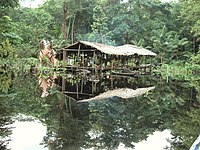This is an old revision of this page, as edited by 198.86.17.162 (talk) at 18:13, 4 September 2009. The present address (URL) is a permanent link to this revision, which may differ significantly from the current revision.
Revision as of 18:13, 4 September 2009 by 198.86.17.162 (talk)(diff) ← Previous revision | Latest revision (diff) | Newer revision → (diff)Dalton and CK were here Venezuela's heritage, art, and culture have been heavily influenced by the Caribbean context. These elements extend to its historic buildings, architecture, art, landscape, boundaries, and monuments. Venezuelan culture has been shaped by indigenous, Spanish and African influences. Before this period, indigenous culture was expressed in art (petroglyphs), crafts, architecture (shabonos), and social organization. Aboriginal culture was subsequently assimilated by Spaniards; over the years, the hybrid culture had diversified by region.
Venezuelan art was initially dominated by religious motifs but began emphasizing historical and heroic representations in the late 19th century, a move led by Martín Tovar y Tovar. Modernism took over in the 20th century. Notable Venezuelan artists include Arturo Michelena, Cristóbal Rojas, Armando Reverón, Manuel Cabré; the kinetic artists Jesús-Rafael Soto and Carlos Cruz-Diez; and contemporary artist Yucef Merhi.
Venezuelan literature originated soon after the Spanish conquest of the mostly pre-literate indigenous societies; it was dominated by Spanish influences. Following the rise of political literature during the War of Independence, Venezuelan Romanticism, notably expounded by Juan Vicente González, emerged as the first important genre in the region. Although mainly focused on narrative writing, Venezuelan literature was advanced by poets such as Andrés Eloy Blanco and Fermín Toro. Major writers and novelists include Rómulo Gallegos, Teresa de la Parra, Arturo Uslar Pietri, Adriano González León, Miguel Otero Silva, and Mariano Picón Salas. The great poet and humanist Andrés Bello was also an educator and intellectual. Others, such as Laureano Vallenilla Lanz and José Gil Fortoul, contributed to Venezuelan Positivism.
Carlos Raúl Villanueva was the most important Venezuelan architect of the modern era; he designed the Central University of Venezuela, (a World Heritage Site) and its Aula Magna. Other notable architectural works include the Capitolio, the Baralt Theatre, the Teresa Carreño Cultural Complex, and the General Rafael Urdaneta Bridge.

Indigenous musical styles of Venezuela are exemplified by the groups Un Solo Pueblo and Serenata Guayanesa. The national musical instrument is the cuatro. Typical musical styles and pieces mainly emerged in and around the llanos region, including Alma Llanera (by Pedro Elías Gutiérrez and Rafael Bolivar Coronado), Florentino y el Diablo (by Alberto Arvelo Torrealba), Concierto en la Llanura by Juan Vicente Torrealba, and Caballo Viejo (by Simón Díaz). The Zulian gaita is also a popular style, generally performed during Christmas. The national dance is the joropo. Teresa Carreño was a world-famous 19th century piano virtuosa. In the last years, Classical Music has had great performances. The Simon Bolivar Youth Orchestra has realized excellent presentations in many European concert halls, notably at the 2007 Proms, and has received honors of the public.
Baseball is Venezuela's most popular sport, although football (soccer), spearheaded by the Venezuela national football team, is gaining influence.
Venezuela is well-known for its successions in beauty pageants. Miss Venezuela is a big event in the country, and Venezuela has received 5 Miss World, 6 Miss Universe and 5 Miss International titles.
The World Values Survey has consistently shown Venezuelans to be among the happiest people in the world, with 55% of those questioned saying they were "very happy".
Etymology

The name "Venezuela" is believed to have originated from Amerigo Vespucci who, along with Alonso de Ojeda, led a 1499 naval expedition along the northwestern coast's Gulf of Venezuela. On reaching the Guajira Peninsula, the crew observed villages (palafitos) that the people had built over the water. This reminded Vespucci of the city of Venice (Template:Lang-it), so he named the region "Venezuola", meaning "little Venice" in Italian. In Spanish, the suffix -zuela is used as a diminutive term (e.g., plaza / plazuela, cazo / cazuela); thus, the term's original sense would have been that of a "little Venice".
Martín Fernández de Enciso, a member of the Vespucci and Ojeda's crew, states in his work Summa de Geografía that the indigenous population they found were called "Veneciuela", suggesting that the name "Venezuela" may have evolved from a native word. The Vespucci story, however, remains the most popular and accepted version of the origin of the country's name.
See also
Main article: Outline of VenezuelaReferences
- "Coro and its Port". UNESCO World Heritage Centre. 1993.
- "Ciudad Universitaria de Caracas". UNESCO World Heritage Centre. 2000.
- "Happiness Statistics By Country". Nationmaster.com. Retrieved 2007-06-21.
- Template:Harvard reference. p. 177.
- Thomas, Hugh (2005). Rivers of Gold: The Rise of the Spanish Empire, from Columbus to Magellan. Random House. p. 189. ISBN 0-37550-204-1.
- "Cuadernos Hispanoamericanos" (in Spanish). Instituto de Cultura Hispánica (Agencia Española de Cooperación Internacional). 1958: 386.
{{cite journal}}: Cite journal requires|journal=(help)
External links
- E-Government (in Spanish)
- Template:Wikitravel
- "Venezuela". The World Factbook (2025 ed.). Central Intelligence Agency.
- Venezuela at UCB Libraries GovPubs
- Template:Dmoz
- Venezuela at Encyclopædia Britannica
- Venezuela from the Library of Congress Country Studies (1990)
- Venezuela Information Office
| |||||||||||
| International membership | |||||||||||||||||||||||||||||||||||||||||||||||||
|---|---|---|---|---|---|---|---|---|---|---|---|---|---|---|---|---|---|---|---|---|---|---|---|---|---|---|---|---|---|---|---|---|---|---|---|---|---|---|---|---|---|---|---|---|---|---|---|---|---|
|
Template:Latin Union Template:Union of South American Nations (Unasur\Unasul)
Template:Mercosur\Mercosul (Southern Common Market)
| |||||||||||||||||||||||||||||||||||||||||||||||||
